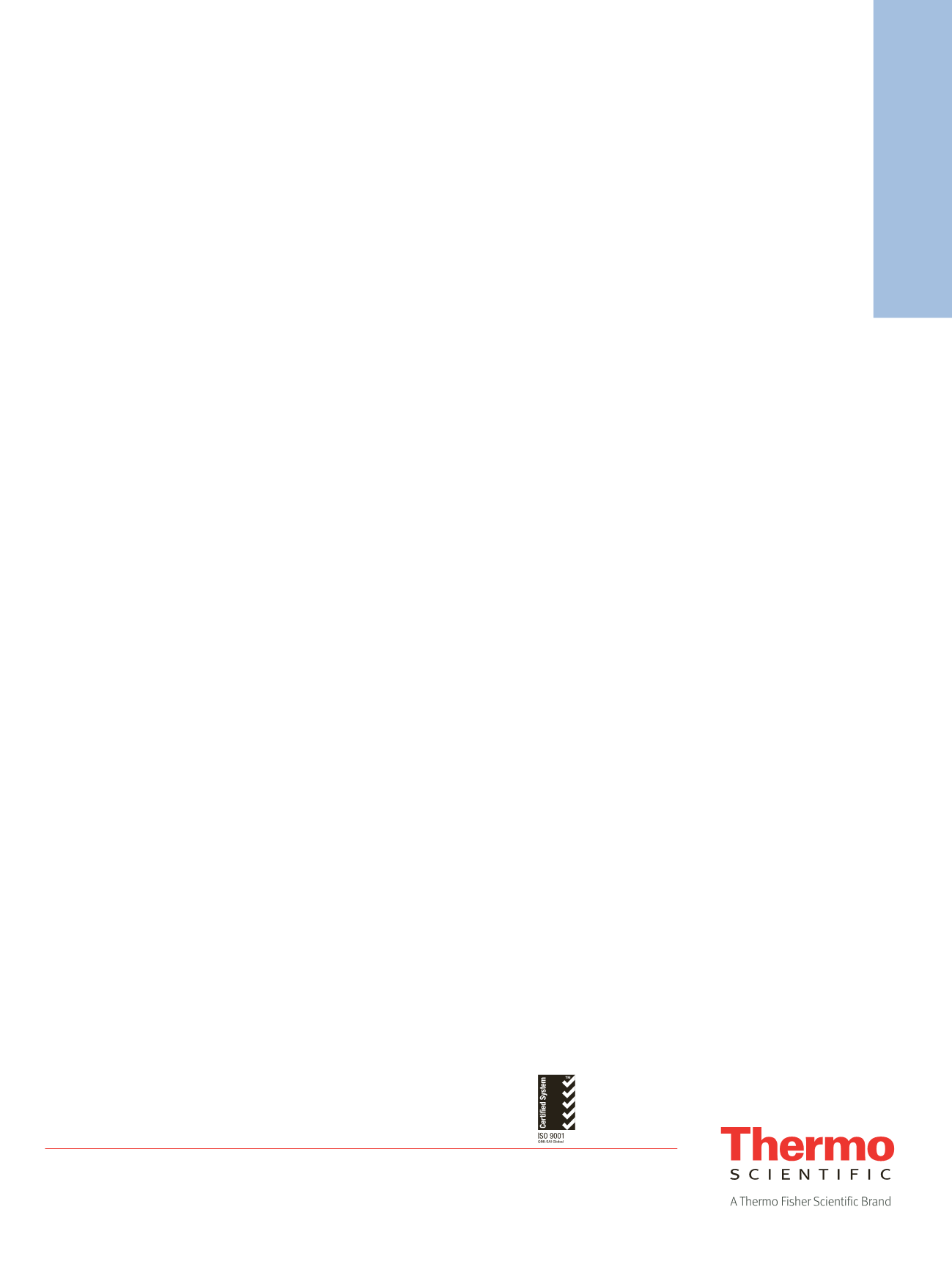

WP64018_E 05/14S
www.thermoscientific.com©2014 Thermo Fisher Scientific Inc. All rights reserved. ISO is a trademark of the International Standards Organization. All other
trademarks are the property of Thermo Fisher Scientific, Inc. and its subsidiaries. Specifications, terms and pricing are subject to
change. Not all products are available in all countries. Please consult your local sales representative for details.
Thermo Fisher Scientific,
San Jose, CA USA
is ISO 9001:2008 Certified.
Africa
+43 1 333 50 34 0
Australia
+61 3 9757 4300
Austria
+43 810 282 206
Belgium
+32 53 73 42 41
Canada
+1 800 530 8447
China
800 810 5118
(free call domestic)
400 650 5118
Denmark
+45 70 23 62 60
Europe-Other
+43 1 333 50 34 0
Finland
+358 9 3291 0200
France
+33 1 60 92 48 00
Germany
+49 6103 408 1014
India
+91 22 6742 9494
Italy
+39 02 950 591
Japan
+81 45 453 9100
Latin America
+1 561 688 8700
Middle East
+43 1 333 50 34 0
Netherlands
+31 76 579 55 55
New Zealand
+64 9 980 6700
Norway
+46 8 556 468 00
Russia/CIS
+43 1 333 50 34 0
Singapore
+65 6289 1190
Spain
+34 914 845 965
Sweden
+46 8 556 468 00
Switzerland
+41 61 716 77 00
UK
+44 1442 233555
USA
+1 800 532 4752
Conclusion
LC-MS is the key technique to be applied in qualitative and quantitative analysis of shellfish toxins
in foods.
Triple quadrupole mass spectrometry presents the traditional approach with benefits of affordability,
robustness, simplicity and applicability in many routine laboratories.
HRAM MS, especially if performed on instruments using an Orbitrap mass analyzer, presents
a state-of-the-art alternative to triple quadrupole MS. The possibility to perform screening,
quantitation and confirmation of an almost unlimited number of compounds in one run improves
lab throughput and lowers the cost per test. At the same time, the data provided by high resolution
instruments allow retrospective analysis.
In the research labs, the possibility to perform complete identification of the new toxins, their
analogues or metabolites opens new areas of research. High-quality MS data obtained by novel
hybrid Orbitrap mass analyzers such as the Thermo Scientific
™
Q Exactive
™
Plus mass spectrom-
eter or Thermo Scientific
™
Orbitrap Fusion
™
Tribrid
™
mass spectrometer provide scientists a great
tool in this very challenging and interesting area of research. The mass accuracy and stability
provided by the new generation of instruments along with ultra-high resolving power deliver
unprecedented confidence in data quality—compared to triple quadrupole or TOF-based MS
systems. The flexibility of both instruments then allows users to collect both quantitative and
qualitative data in a single run and to accelerate the delivery of results both in routine and
research labs.
Supporting Material
Application notes 63552 and 52154
References and Acknowledgements
1. European Parliament, Regulation 853/2004/EC, Off.
J. Eur. Common
.
2004
, 139, 55.
2. European Commission, Commission Regulation 15/2011/EC,
Off. J. Eur. Common
.
2011
,
279, 5.
3. Kaufmann
et al
,
Analytical Chemical Act
2010
, Volume 673, Issue 1, 60-72.
4. A.A. Makarov, ‘Electrostatic Axially Harmonic Orbital Trapping: A High-performance
Technique of Mass Analysis’,
Anal. Chem
.
2000
, 72, 1156–1162.
5. Application Note 63552: Determination of Lipophilic Marine Biotoxins in Mollusks
by LC-MS/MS using Offline Extraction,
Thermo Fisher Scientific
2013.
6. European Union Reference Laboratory for Marine Biotoxins,
EU-RL-MB SOP
2011
,
Version 4.
7. Application Note 52154: Non-Targeted Screening of Lipophilic Marine Biotoxins by Liquid
Chromatography – High-Resolution Mass Spectrometry,
Thermo Fisher Scientific
2011
.
8. Domenech
et al
,
Journal of Chromatography A
2014
, Volume 1328, 16–25.
9. European Commission, 2002/657/EC,
Off. J. Eur. Common
.
2002
, 221.
10. Giessen
et al
.
Analytica Chimica Acta
2011
, 685, 176–185.
11. Ciminiello
et al
;
Rapid Commun. Mass Spectrom
.
2010
, 24, 2735–2744.
White Paper 64018



















